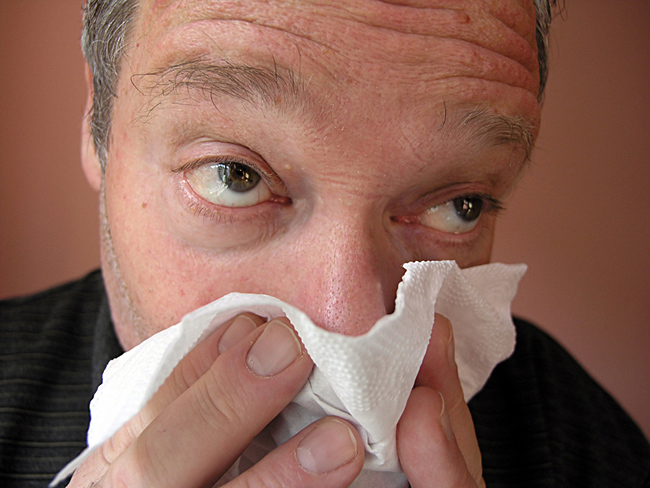Whooping Cough Makes Whopping Comeback

Whooping cough sounds fantastically antiquated, up there with scurvy and St. Vitus Dance — diseases you didn't think anyone in America got anymore.
But whooping cough, named for the high-pitched "whoop" a person makes when inhaling, has made a comeback, with an incidence rate up by a whopping 2,300 percent since 1976, the year when fear of the vaccine began to take hold and vaccination rates started to plummet. In 1976 there were only about 1,000 reported cases; in 2005, the most recent peak, there were nearly 27,000 reported cases (and likely over 1 million unreported cases), according to the Centers for Disease Control and Prevention.
With outbreaks that cycle every three to five years, the respiratory tract infection might peak again this year, and the CDC recommends you get a booster shot soon.
We're not off to a good start. In June, California declared a whooping cough epidemic after the death of five infants. So far there have been nearly 3,000 reported cases across six states, according to the CDC, a sevenfold increase compared with this time last year. Whooping cough season doesn't really kick in until the fall.
A reversing trend
Whooping cough, known in the medical trade by its more conservative name, pertussis, is nearly completely preventable through vaccination. Pertussis was once a leading cause of infant death, with over a quarter million cases and about 8,000 total deaths annually in the United States during the peak years in the 1930s, just before the advent of the vaccine in the 1940s, according to CDC statistics.
By the 1970s, through vaccinations, whooping cough was as endangered as the whooping crane, with only about 0.000005 percent of the population infected. Unfortunately, fears that the DPT vaccine (a combo for diphtheria, pertussis and tetanus) could cause brain damage in rare cases — not entirely unfounded — gave rise to the anti-DPT movement in many industrialized countries.
Get the world’s most fascinating discoveries delivered straight to your inbox.
At issue was the "whole-cell pertussis" element of the vaccine, since replaced in most countries, including the United States, with an "acellular" formulation (which includes purified proteins from the Bordetella pertussis bacteria), indicated by the "a" in DTaP, a common abbreviation for the vaccine these days. While never conclusively associated with brain damage, the original formulation was tied to other serious albeit rare side effects, such as allergic reactions and seizures.
Hype and consequences
The impact of the anti-vaccine movement was dramatic. In Great Britain, immunization rates for whooping cough dropped from over 80 percent to 33 percent (and in some regions to less than 10 percent) from 1974 to 1977. Then the epidemic hit. In 1979 there were over 100,000 cases and 36 deaths worldwide. In Japan in 1975, amidst public worry, the government suspended mandatory pertussis vaccines for infants; the 1979 epidemic killed over 40 children there. The same scene repeated itself in other countries, as well.
In June 2009 researchers reported in the journal Pediatrics that children who didn't receive the whooping cough vaccine were 23 times more likely to contract pertussis. In the June 2010 issue of Pediatrics, researchers found no connection between the vaccine and seizures.
Herd mentality
The recent upsurge of whooping cough cases is not entirely the fault of the anti-vaccine movement. For the pertussis incidence rates to remain low — even among the vaccinated, because the vaccine isn't 100-percent effective — there needs to be herd protection, in this case over 90 percent of the entire population immunized, to minimize the number of carriers.
Fewer than 85 percent of children are fully immunized against pertussis, according to the CDC. Some parents simply forget to keep up the multi-shot schedule. And for adults, vaccinated as children, the strength of the immunization has waned.
To curb the epidemic, the CDC is recommending that adults get a booster shot. Most adults have never received one and have never been told to get one.
Going natural is perhaps not the best bet. While pertussis is rarely deadly for otherwise healthy adults, struggling through the aptly named "100-day cough" isn't particularly pleasant, with its uncontrollable fits of violent coughing around the clock.
Also, in the August 2010 edition of Clinical Infectious Diseases, James Cherry of the David Geffen School of Medicine at UCLA addresses a common myth that living through a bout of pertussis offers lifetime immunity. Not so. Protection from the vaccine and booster lasts longer, although no more than 10 years.
One limiting factor for a fully immunized population could be the fact that, for adults, the booster shot might not be covered by medical insurance. So your decision might come down to coughing it up now or coughing it up later.

Christopher Wanjek is a Live Science contributor and a health and science writer. He is the author of three science books: Spacefarers (2020), Food at Work (2005) and Bad Medicine (2003). His "Food at Work" book and project, concerning workers' health, safety and productivity, was commissioned by the U.N.'s International Labor Organization. For Live Science, Christopher covers public health, nutrition and biology, and he has written extensively for The Washington Post and Sky & Telescope among others, as well as for the NASA Goddard Space Flight Center, where he was a senior writer. Christopher holds a Master of Health degree from Harvard School of Public Health and a degree in journalism from Temple University.


